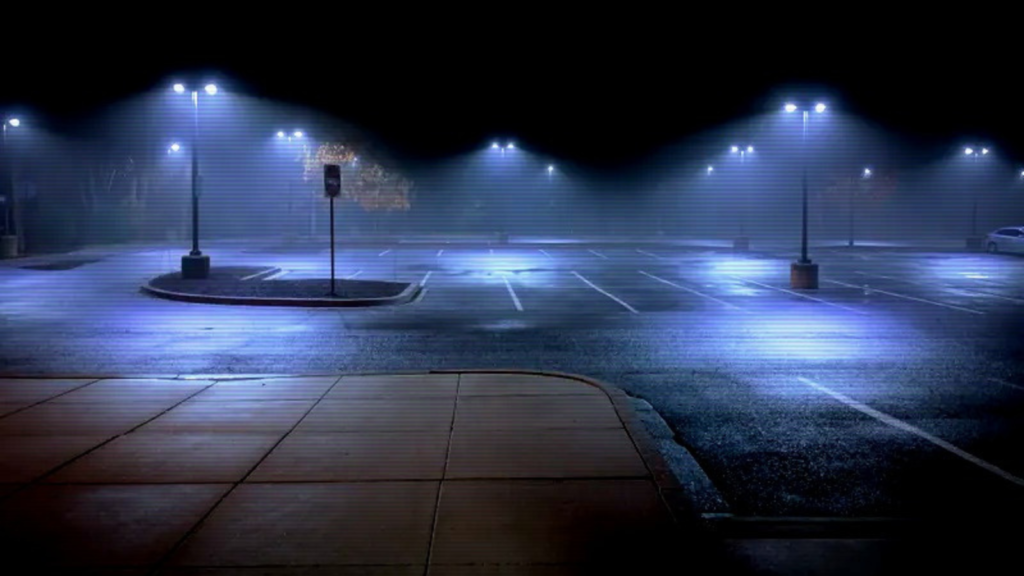
Night is not the right time to come here. The parking lot never contains more than a spattering of cars to give some hint of the presence of life. But now in this grim time, after most sensible people have finished their dinners and are filling the screaming void of their lives with the sound of television, the wide expanse of asphalt is home to nothing but dead leaves. Rain has plastered the scabby yellow detritus to the slick blacktop, which gleams like a pond of oil under the sodium lights. By the iron grated drains and in the crumbling potholes evidence of rain stagnates and grows spiderwebs of frost at their edges.
The storage facility looms over it all, three floors of whitewashed monolithic concrete. An extra story rises at the corner closest to the street, where the main door lies. This formidable square turret bears glowing letters in pumpkin-orange plastic that spell the words: Lockers for Life Self Storage.
The wind’s cries almost drown out the perpetual Doppler buzz of the highway and the screech of brakes from the off-ramp. November has given sandpaper to the air, and it scratches against the nylon of a coat and brushes cheeks red. Yet, the building’s interior offers little respite, and the illusion of warmth is swiftly dispelled. The lone attendant’s sweater and zipped-up jacket attest to the eternal dank chill that lingers here. The light is harsh against the white walls and an odor of moldering cardboard fills the air with a mushroom bloom of earth and fungal damp.
A man, young and unshaven, sits behind a counter bisecting the room in two. This barrier makes it appear that he is merely here to mind the stacks of folded boxes, bales of bubble wrap, and rolls of packing tape behind him. But his real role is to guard the set of steel doors opposite the glass one still held partially open by the night’s restless wind. He looks up from his well-thumbed paperback to glance at his watch and offer a silent admonishment at the lateness of the hour. However, the facility doesn’t turn out the lights until eleven, and he returns to his fictions of science and imagination.
Beyond this checkpoint, the chill takes on a sepulchral note. The earthy scent is replaced by a minerality of stone, chalk, and lime dust. The cinder blocks have leeched up the damp for years and imbue the long hall with a sense of the subterranean, as if this corridor ran miles below the surface instead of above it. The light is the same barrage of fluorescence as the outer chamber, but here their glare is subdued, made anemic by the vaulted height and expansive width of the passage, not to mention the grays and rusts permeating the palette of this dismal panorama.
The rollup doors have been painted ochre brown, perhaps to conceal the inevitable oxidization that foxes the border of each of their slats. They are staggered irregularly along one wall, denoting the various sized lockers that are available for rent at reasonable rates. At a junction, a second hall sprouts to the left and distinguishes itself only in that it has doors running along both its walls.
Down this passage, no sound disturbs the vast slumber of the vaults and their inanimate inhabitants, except the rustling of an unswept bag. Its sodium laden contents have been consumed and the brittle crimson husk crinkles under the rhythmic breath of a heating vent.
At the terminus of this route, locker 199 waits patiently on the right.
Its door rises easily as though oiled recently and often, although neither is the case.
Here rests the last remnants of The Old Man, packed away after his death and stacked floor to ceiling in tight rows with only a narrow gap to allow ingress into the deeper recesses of the locker. Caged bulbs backlight the furniture, boxes, and plastic bins. The ambiance is not unlike The Old Man’s house back in those older, livelier days. Except, the newspapers, pizza boxes, used tissues, and other refuse specked with mouse dropping have been dispersed in the town dump, along with the odoriferous appliances and all the upholstered furniture. What remains is a mutilation. A maimed and incomplete portrait of the man and his life now passed.
The dense tangle of objects, one on top of another and coated thick with dust, suggest neglect and disdain. But there is love in this space. The Old Man poured such copious devotion into each and every article, they almost glow with his aura. So prominent is his spirit that individual objects become lost in the unified whole—a single entity merely biding its time in this too-small prison cell.
A strong will is needed to see beyond this organism of possessions to the intertwined monkey-bars of dining room chairs. Or the collection of lamps with bases made from ceramic, brass, and driftwood. Some with faces that leer from the shadows in the visage of bears, deer, and fishermen. But most unsettling are the clowns, which appear with uncommon regularity.
Although, in truth, the most disconcerting elements to be found are the transparent bins at the top of the stacks.
Lit from behind, they contain the silhouettes of a multitude of small arms and legs with the occasional bulbous shape which suggests a skull or a spider’s body. A rational mind would dismiss these vague forms as nothing but a doll collection.
An ornate wardrobe at the very back gives a hint toward the legacy of wealth that once existed in the family. Cherubs dance around a fruit motif in the dark stain of its oak. A faint trace of movement blurs over the surface of its dust-caked mirror.
It isn’t easy traversing the narrow passage leading to it. The stacks provide a gauntlet of sharp edges and protruding corners to hamper the would-be Orpheus. The delay allows the creature (a mouse or some other vermin) to vanish amid the vast clutter.
Except… There it is, in the mirror, again.
Should fingers clear away the layers of furry dirt, sloughed-off skin, and the corpses of mites a peculiar sight is revealed. An eye, blue and cloudy as a murky pool, stares back through the streak on the glass. Yet, no corresponding statue or figurine can be found in the disarray of The Old Man’s collection.
The eye blinks once and fades back into the shadows.
There is no point in waiting. It does not return. But when the phenomenon is dismissed as a trick of the light or a symptom of fatigue, the rollup door is discovered to be down.
The bearings and tracks were silent as though they’d been lubricated beyond the thoroughness of human ability. It should come as a surprise that it is locked, but a heavy air of inevitability fills the locker. The oxygen becomes opium sweet and puts an end to screaming and fighting. A sudden heat wraps all in a loving embrace.
Long has the collection waited here. Its eternal need to grow and expand stunted by abandonment. But never has it forgotten. Its vigil has not waned. For in The Old Man’s collection, there is always room for more.

David J. Thirteen
David J. Thirteen is a writer of horror and other dark fiction living in Toronto, Ontario, Canada. His short fiction has been featured in Lamplight Magazine,The Other Stories Podcast, and various anthologies.
